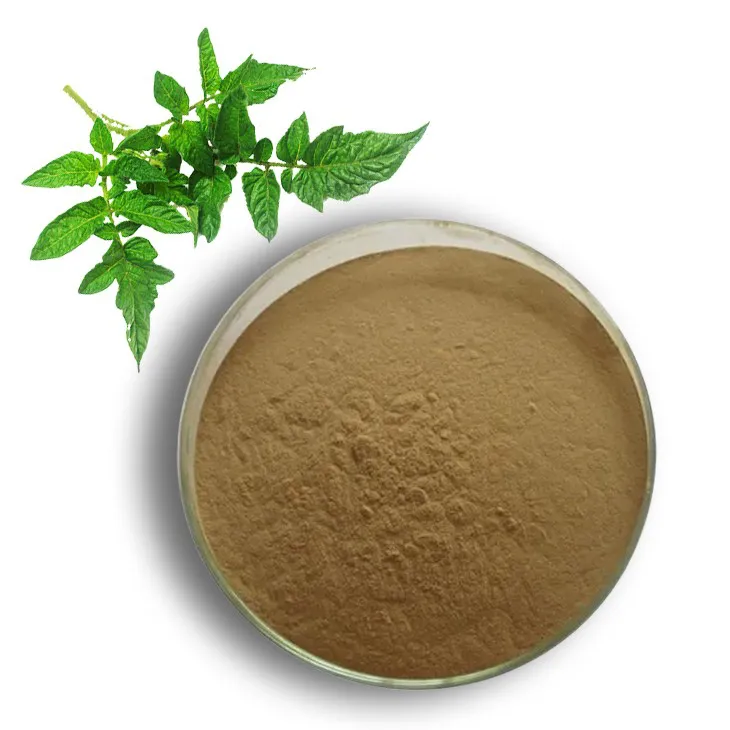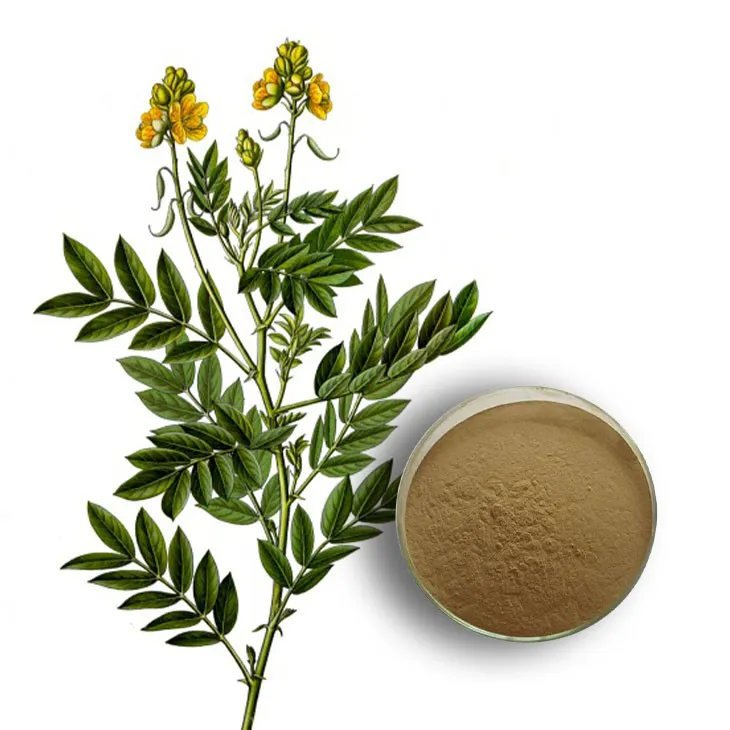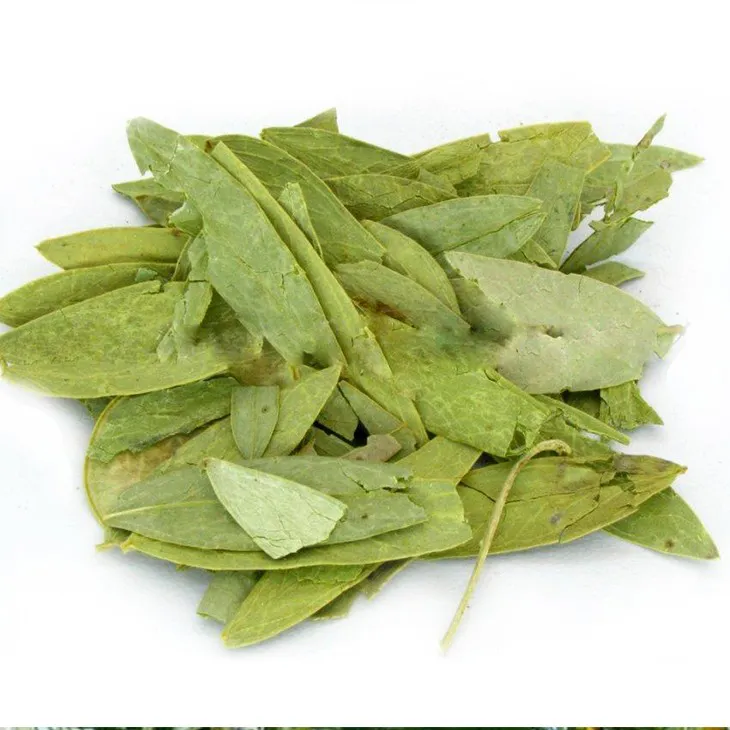- 0086-571-85302990
- sales@greenskybio.com
The process of extracting senna anthraquinone from senna leaf extract.
2024-11-29

1. Introduction
Senna is a well - known plant that has been used in traditional medicine for centuries. Senna Leaf Extract contains various bioactive compounds, with senna anthraquinone being one of the most important. Senna anthraquinone has a wide range of pharmacological activities, such as laxative effects. Due to its potential applications in the pharmaceutical and nutraceutical industries, the extraction of senna anthraquinone from Senna Leaf Extract has become an area of significant research interest. However, achieving efficient extraction while maintaining high purity and minimizing environmental impact is a complex task.

2. Traditional Extraction Methods
2.1 Solvent Extraction
Solvent extraction is one of the most commonly used traditional methods.
- In this method, a suitable solvent is selected. Common solvents include ethanol, methanol, and chloroform. Ethanol is often preferred due to its relatively low toxicity and good solubility for anthraquinone compounds.
- The Senna Leaf Extract is mixed with the solvent in a certain ratio. For example, a ratio of 1:10 (extract to solvent) may be used.
- The mixture is then stirred for a specific period, usually several hours, to ensure sufficient contact between the solvent and the compounds in the extract.
- After stirring, the mixture is filtered to separate the liquid phase (containing the dissolved anthraquinone) from the solid residue.
- The solvent is then evaporated, typically under reduced pressure, to obtain the senna anthraquinone. However, this method has some drawbacks. The use of organic solvents may pose environmental and safety risks, and the extraction efficiency may not be very high in some cases.
2.2 Soxhlet Extraction
Soxhlet extraction is another traditional approach.
- The senna leaf extract is placed in a Soxhlet thimble.
- A suitable solvent, such as hexane or petroleum ether, is added to the Soxhlet apparatus.
- The solvent is heated and continuously refluxed through the extract in the thimble for an extended period, often several days. This continuous refluxing helps in the extraction of anthraquinone.
- Once the extraction is complete, the solvent is evaporated to obtain the senna anthraquinone. However, Soxhlet extraction is time - consuming and also requires a large amount of solvent, which can be expensive and environmentally unfriendly.

3. Modern and Advanced Extraction Techniques
3.1 Supercritical Fluid Extraction (SFE)
Supercritical fluid extraction has emerged as a promising technique.
- In SFE, carbon dioxide (CO₂) is often used as the supercritical fluid. CO₂ is non - toxic, non - flammable, and has a relatively low critical temperature and pressure, which makes it suitable for extracting heat - sensitive compounds like senna anthraquinone.
- The senna leaf extract is placed in an extraction vessel. The supercritical CO₂ is then passed through the extract under specific temperature and pressure conditions. For example, a pressure of around 20 - 30 MPa and a temperature of 40 - 60 °C may be used.
- The supercritical CO₂ selectively dissolves the senna anthraquinone and other target compounds.
- By adjusting the pressure and temperature, the solubility of the compounds in the supercritical fluid can be controlled, allowing for better separation and purification.
- After extraction, the supercritical CO₂ is depressurized, and the extracted compounds are collected. SFE offers several advantages over traditional methods, including higher extraction efficiency, better product quality, and reduced environmental impact. However, the equipment for SFE is relatively expensive.
3.2 Microwave - Assisted Extraction (MAE)
Microwave - assisted extraction is another modern technique.
- In MAE, the senna leaf extract is placed in a microwave - transparent vessel along with a suitable solvent.
- The microwave energy is then applied to the mixture. The microwaves cause rapid heating of the solvent and the extract, which enhances the mass transfer and extraction efficiency.
- The extraction time in MAE is much shorter compared to traditional methods. For example, it may take only a few minutes to several tens of minutes, depending on the power of the microwave and the nature of the extract.
- After extraction, the mixture is filtered and the solvent is evaporated to obtain the senna anthraquinone. MAE can significantly improve extraction efficiency, but it requires careful control of microwave power and extraction time to avoid over - extraction or degradation of the compounds.
3.3 Ultrasound - Assisted Extraction (UAE)
Ultrasound - assisted extraction is also being widely explored.
- In UAE, an ultrasonic transducer is used to generate ultrasonic waves in a solvent - senna leaf extract mixture.
- The ultrasonic waves create cavitation bubbles in the solvent. When these bubbles collapse, they generate high - pressure and high - temperature micro - environments, which help in breaking the cell walls of the plant material in the extract and releasing the senna anthraquinone.
- The extraction process in UAE is relatively fast and can be completed within a short time, usually less than an hour.
- After extraction, the mixture is filtered and the solvent is removed to obtain the desired product. UAE is a cost - effective and efficient extraction method, but it may also require optimization of ultrasonic parameters such as frequency and power.

4. Factors Affecting Extraction Efficiency
4.1 Particle Size of Senna Leaf Extract
The particle size of the senna leaf extract plays an important role in extraction efficiency.
- Smaller particle sizes generally result in higher extraction efficiency. This is because smaller particles have a larger surface area exposed to the solvent or extraction medium. For example, if the senna leaf extract is ground into a fine powder, the solvent can more easily penetrate and interact with the compounds inside the particles, facilitating the extraction of senna anthraquinone.
- However, if the particles are too small, there may be problems such as aggregation or clogging during extraction, which can actually reduce the extraction efficiency. Therefore, an optimal particle size needs to be determined for different extraction methods.
4.2 Solvent Type and Concentration
The choice of solvent type and its concentration significantly affects extraction.
- As mentioned earlier, different solvents have different solubility properties for senna anthraquinone. For example, polar solvents like ethanol are more suitable for extracting polar anthraquinone compounds, while non - polar solvents may be better for non - polar related substances.
- The concentration of the solvent also matters. A higher solvent concentration may increase the driving force for extraction, but it may also lead to the extraction of unwanted impurities. Therefore, an appropriate solvent concentration needs to be optimized based on the nature of the extract and the desired purity of the senna anthraquinone product.
4.3 Extraction Time and Temperature
- Extraction time is a crucial factor. In traditional methods like solvent extraction, longer extraction times may be required to achieve sufficient extraction. However, in modern methods such as microwave - assisted extraction, the extraction time is much shorter. Prolonged extraction time may lead to degradation of the senna anthraquinone or extraction of unwanted compounds.
- Temperature also has a significant impact. Higher temperatures can generally increase the solubility of the compounds in the solvent and thus improve extraction efficiency. But for heat - sensitive compounds like senna anthraquinone, excessive heat can cause decomposition. Therefore, in methods like supercritical fluid extraction, the temperature needs to be carefully controlled within an appropriate range.
5. Purity Considerations
Achieving high purity of senna anthraquinone is essential for its applications in the pharmaceutical and nutraceutical industries.
- After extraction, the crude product may contain various impurities, including other plant compounds, residual solvents, and degradation products. Purification steps are often required to remove these impurities.
- One common purification method is chromatography. Column chromatography, for example, can be used to separate senna anthraquinone from other compounds based on their different affinities to the stationary and mobile phases.
- Recrystallization is another method. By dissolving the crude product in a suitable solvent and then allowing it to recrystallize slowly, impurities can be left in the solution while the pure senna anthraquinone forms crystals.
6. Environmental Impact
Minimizing the environmental impact of the extraction process is becoming increasingly important.
- Traditional extraction methods using large amounts of organic solvents pose significant environmental risks. These solvents may be volatile and contribute to air pollution, or if not properly disposed of, can contaminate soil and water.
- Modern methods like supercritical fluid extraction, which use non - toxic and environmentally friendly supercritical fluids like CO₂, have a much lower environmental impact. However, the energy consumption of some modern methods, such as microwave - assisted extraction and supercritical fluid extraction, needs to be considered. Optimizing the extraction process to reduce energy consumption can further improve the environmental friendliness of the process.
7. Conclusion
The extraction of senna anthraquinone from senna leaf extract is a complex process that involves various methods and considerations. Traditional methods such as solvent extraction and Soxhlet extraction have been widely used but have certain limitations. Modern techniques like supercritical fluid extraction, microwave - assisted extraction, and ultrasound - assisted extraction offer improved extraction efficiency, better product quality, and reduced environmental impact in some cases. Factors such as particle size, solvent type, extraction time, and temperature need to be carefully optimized to achieve high - efficiency extraction and high - purity products. Purification steps are also necessary to ensure the quality of the final senna anthraquinone product. Considering the environmental impact is crucial for the sustainable development of the extraction process. Overall, further research and development in this area are expected to lead to more efficient, environmentally friendly, and high - quality extraction processes for senna anthraquinone.
FAQ:
What are the common methods for extracting senna anthraquinone from senna leaf extract?
Some common methods include solvent extraction, for example, using organic solvents like ethanol or methanol. Supercritical fluid extraction is also a method that can be used, which often offers advantages in terms of extraction efficiency and selectivity. Additionally, microwave - assisted extraction can be applied to enhance the extraction process.
How can the extraction efficiency of senna anthraquinone be improved?
One way is to optimize the extraction parameters. For solvent extraction, adjusting factors such as solvent concentration, extraction time, and temperature can have a significant impact. Using appropriate pre - treatment methods on the senna leaf extract, like grinding to a finer particle size, can also increase the surface area available for extraction, thereby improving efficiency. Another approach could be the use of adjuvants or catalysts in the extraction process, if they are compatible with the overall extraction system.
What factors need to be considered regarding the purity of the extracted senna anthraquinone?
The choice of extraction method is crucial as some methods may introduce impurities more easily than others. For example, if a solvent with a complex composition is used, it may leave behind unwanted residues. The purification steps following extraction also play a vital role. Techniques such as filtration, chromatography (e.g., column chromatography), and crystallization can be employed to increase purity. Additionally, the quality of the starting senna leaf extract can affect the purity of the final product, so ensuring the quality of the raw material is important.
How does the extraction process of senna anthraquinone impact the environment?
If organic solvents are used in large quantities in the extraction process, their disposal can pose environmental problems. Solvents that are volatile and toxic can contribute to air pollution if not properly managed. Also, waste generated during the extraction and purification processes, such as spent plant material and chemical residues, needs to be disposed of in an environmentally friendly way. Therefore, methods that are more environmentally friendly, like supercritical fluid extraction which can use carbon dioxide as a solvent, are becoming more popular as they can reduce the environmental impact.
What are the applications of the extracted senna anthraquinone?
Senna anthraquinone has applications in the pharmaceutical industry. It has been used for its laxative properties in some traditional and modern medicine formulations. In addition, it may also have potential in the field of cosmetics, perhaps for its antioxidant or other biological activities that could be beneficial for skin health, although more research is needed in this area.
Related literature
- Extraction and Characterization of Anthraquinones from Senna Leaves"
- "Optimization of Senna Anthraquinone Extraction: A Review"
- "Environmental - Friendly Extraction of Senna Anthraquinone: New Approaches"
- ▶ Hesperidin
- ▶ citrus bioflavonoids
- ▶ plant extract
- ▶ lycopene
- ▶ Diosmin
- ▶ Grape seed extract
- ▶ Sea buckthorn Juice Powder
- ▶ Beetroot powder
- ▶ Hops Extract
- ▶ Artichoke Extract
- ▶ Reishi mushroom extract
- ▶ Astaxanthin
- ▶ Green Tea Extract
- ▶ Curcumin Extract
- ▶ Horse Chestnut Extract
- ▶ Other Problems
- ▶ Boswellia Serrata Extract
- ▶ Resveratrol Extract
- ▶ Marigold Extract
- ▶ Grape Leaf Extract
- ▶ blog3
- ▶ blog4
-
Chinese peppermint oil powder factories.
2024-11-29
-
The best green tea extract on the market.
2024-11-29
-
Nature's Bounty Okra Extract.
2024-11-29
-
Chinese Oyster Peptide Powder Factories.
2024-11-29
-
The best organic L - carnitine.
2024-11-29
-
Certified organic acerola cherry extract.
2024-11-29
-
Fenugreek Extract Powder
2024-11-29
-
Selenium yeast
2024-11-29
-
Moringa powder
2024-11-29
-
Citrus bioflavonoids
2024-11-29
-
Clove Powder
2024-11-29
-
Pomegranate Extract
2024-11-29
-
Horse Chestnut Extract
2024-11-29
-
Hops Extract
2024-11-29
-
Eucommia Ulmoides Extract
2024-11-29
-
Acerola Extract
2024-11-29





















